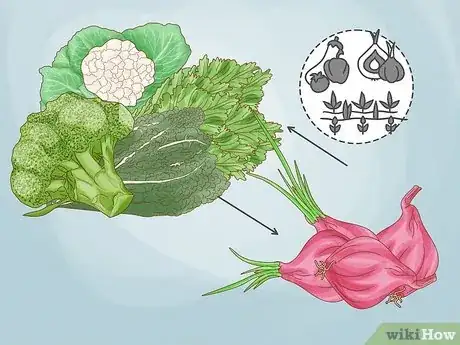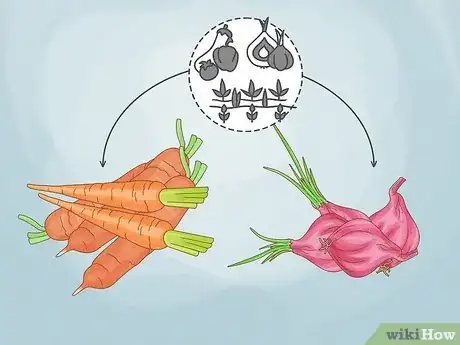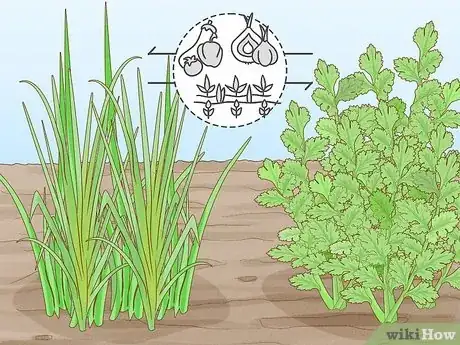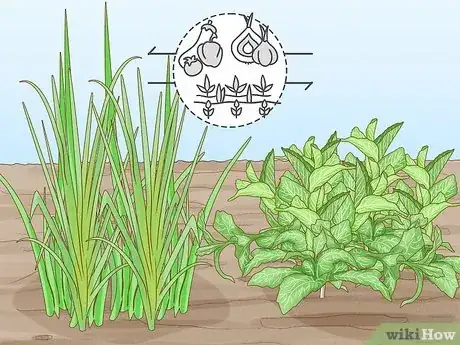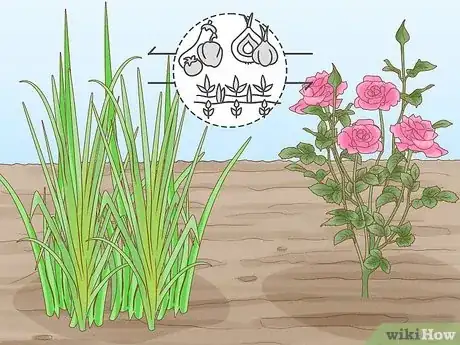This article was co-authored by wikiHow staff writer, Hannah Madden. Hannah Madden is a writer, editor, and artist currently living in Portland, Oregon. In 2018, she graduated from Portland State University with a B.S. in Environmental Studies. Hannah enjoys writing articles about conservation, sustainability, and eco-friendly products. When she isn’t writing, you can find Hannah working on hand embroidery projects and listening to music.
Learn more...
Whether you’re growing large, bulbous onions or skinny scallion stalks, companion planting can help keep pests away and speed up the growth of your crops. By picking the right plants, you can help your onions thrive rather than just survive. Plus, onions make great companions to other plants too, because their strong scent confuses and repels pests. That’s why we’ve compiled a list of the best veggies, fruits, herbs, and even flowers you can plant alongside onions for great results. Let’s get planting!
Things You Should Know
- Repel pests from your onions by planting cabbage and garlic nearby.
- Get rid of onion flies by mixing in carrots with your onion patch.
- Enhance the flavor of your onions by planting chamomile and dill in your garden.
- Draw essential nutrients up from the soil with weeds like sow thistle and pigweed.
Steps
Cabbage
-
Members of the brassica family help repel pests. If you’re worried about your onion crops being overrun by pests like wireworms, then choose any member of the cabbage family to plant alongside them. Try veggies like:[1] X Research source
- Broccoli
- Cauliflower
- Mustard
- Kale
Garlic
-
Other members of the allium family need the same conditions as onions. Plus, they help repel common pests, like slugs, aphids, and cabbage worms. Try planting crops like:[2] X Research source
- Garlic
- Leeks
- Chives
Carrots
-
Carrots help get rid of onion flies. And not only do the carrots help the onions, but the onions help the carrots, too! Onions help repel carrot flies, so it’s a win-win scenario.[3] X Research source
- When planting carrots, choose an area with full to partial sunlight throughout the day for best results.
Tomatoes
-
Onions keep pests away from members of the nightshade family. If you want a garden full of tomatoes, peppers, or eggplant that aren’t full of aphid holes, then plant them near your onions. The smell of onions helps repel and confuse pests that may nibble on these vegetables.[4] X Research source
- Onions also help repel pests from squash, cucumbers, and zucchini.
Beets
-
Root crops need fewer nutrients in general. Plus, since beets and onions both grow underground, they thrive under the same conditions. Grow beets in the ground, in a raised bed, or in pots alongside the onions.[5] X Research source
Parsnips
-
Parsnips are root vegetables that help control pests. Parsnips and onions do well in the same conditions, but they won’t compete for a lot of nutrients.[6] X Research source Plus, the strong smell of onion helps deter aphids and flea beetles that can decimate parsnip crops.
- To grow parsnips, sow them in mid-spring in an area that gets 6 or more hours of sunlight per day.
Potatoes
-
Potatoes help repel beetles that might munch on your onions. And, since potatoes also grow underground, they do well in most of the same conditions that onions do.[7] X Research source Potatoes are also a great crop for beginning gardeners to try, since they’re so easy to grow!
- Grow potatoes using seed potatoes, or whole potatoes left over from last year’s harvest.
Lettuce
-
Lettuce doesn’t take up a lot of space, so it fits nicely in between onions. If you’re looking to confuse pests and break up rows of onion plants, lettuce is the right veggie for you![8] X Research source Plus, the smell of onions helps keep pests away that might eat your lettuce.
- Start growing lettuce by sowing seeds indoors before transplanting them outside.
- The same is true for other leafy greens, like chard and spinach.
Strawberries
-
The smell of onions keeps pests away from strawberries. Are you tired of caterpillars and beetles munching on your fruit? Plant strawberries with a border of onions around them. Pests will smell the onions and get confused, leading them to look elsewhere.[9] X Research source
- Planting strawberries next to onions won’t give your fruit an onion-y flavor—that’s just a myth!
Chamomile
-
Chamomile boosts the flavor of onions nearby. Seasoned gardeners know that combining chamomile crops and onion crops will make your onions grow faster and taste better.[10] X Research source Plus, you can use chamomile in herbal remedies and to make tea.
- Start growing chamomile 6 weeks indoors before you transplant it outside.
Dill
-
Dill helps onions grow faster. Intercropping your onion plants with dill will speed up their growth and may also enhance their flavor.[11] X Research source Plus, dill is a great herb to have on-hand for a variety of recipes.
- To grow dill outside, pick a spot that gets around 7 hours of sunlight per day.
Parsley
-
Parsley repels and confuses pests. Since parsley is similar to the carrot family, growing parsley and onions together helps keep onion flies away.[12] X Research source Parsley is an herb used in tons of dishes, and it’s a great flavor to have on-hand for any recipe.
- Start growing parsley indoors 6 to 8 weeks before moving the seedlings outside.
Summer savory
-
Use summer savory to improve the flavor and growth of your onions. Similar to chamomile, summer savory is great for onion growth and taste. Plus, summer savory helps repel beetles, ensuring that your crops won’t get munched on.[13] X Research source
- Summer savory is similar to thyme. Its peppery, sharp flavor is a great addition to chicken and fish dishes.
Mint
-
Mint repels and confuses onion flies, a common pest. If pests are your main concern, plant mint around your crop to mask the smell of your onions.[14] X Research source Just keep in mind that mint can easily take over a garden bed, so be sure to prune it back whenever it starts growing.
- You can grow mint from an existing plant, or you can grow it from seed.
Marigolds
-
Marigolds prevent nematodes from eating your onions. If you know your soil has nematodes, then marigold is the flower for you: their roots produce a substance that is toxic to nematodes in the soil.[15] X Research source Plant marigold flowers around your onions for a beautiful, beneficial flower.
- In most growing zones, marigolds are annual plants, meaning they’ll die off in the winter and won’t come back in the spring.
Sow thistle
-
Sow thistle brings nutrients to the soil to help your onions grow. While it’s technically a weed, sow thistle draws up nutrients out of the deep soil that can increase the growth of your other crops.[16] X Research source Plus, as sow thistles die and fall into the soil, they provide essential nutrients to plants growing nearby.
- Sow thistle is a perennial herb, meaning it will come back year after year.
Pigweed
-
Pigweed accumulates nutrients that are beneficial to onions. Similar to sow thistle, this weed helps draw nutrients from the soil to your crops.[17] X Research source Pigweed is also a great crop to plant alongside corn.
- The leaves of pigweed are edible, and contain essential nutrients like vitamins A and C.
Roses
-
Onions can help repel pests from your rose bushes. If you have rose plants in your yard, you probably know that aphids and beetles love to munch on their leaves. Plant onions nearby to mask the smell of roses and confuse pests.[18] X Research source
You Might Also Like













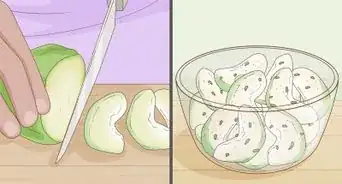
References
- ↑ https://www.farmaid.org/wp-content/uploads/2018/09/companion_planting_chart.pdf
- ↑ https://www.gardenersworld.com/plants/10-companion-plants-to-grow/
- ↑ https://www.bobvila.com/articles/companion-planting/
- ↑ https://www.bobvila.com/articles/companion-planting/
- ↑ https://www.bobvila.com/articles/companion-planting/
- ↑ https://www.victoryliving.co.uk/victory-gardening/companion-planting
- ↑ https://www.bobvila.com/articles/companion-planting/
- ↑ https://www.bobvila.com/articles/companion-planting/
- ↑ https://www.bobvila.com/articles/companion-planting/
- ↑ https://www.fpconservatory.org/wp-content/uploads/2018/11/3-Companion-Planting-PDF.pdf
- ↑ https://www.fpconservatory.org/wp-content/uploads/2018/11/3-Companion-Planting-PDF.pdf
- ↑ https://www.fpconservatory.org/wp-content/uploads/2018/11/3-Companion-Planting-PDF.pdf
- ↑ https://www.fpconservatory.org/wp-content/uploads/2018/11/3-Companion-Planting-PDF.pdf
- ↑ https://www.fpconservatory.org/wp-content/uploads/2018/11/3-Companion-Planting-PDF.pdf
- ↑ https://www.lsuagcenter.com/profiles/coverstreet/articles/page1486135407127
- ↑ https://www.fpconservatory.org/wp-content/uploads/2018/11/3-Companion-Planting-PDF.pdf
- ↑ https://www.fpconservatory.org/wp-content/uploads/2018/11/3-Companion-Planting-PDF.pdf
- ↑ https://www.gardenersworld.com/plants/10-companion-plants-to-grow/
- ↑ https://www.gardenersworld.com/plants/10-companion-plants-to-grow/
- ↑ https://www.gardenersworld.com/plants/10-companion-plants-to-grow/
About This Article

